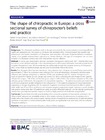The shape of chiropractic in Europe: A cross sectional survey of chiropractor's beliefs and practice

Abstract
Background: The chiropractic profession both in the past and presently has diverse opinions concerning different health care approaches and the science or otherwise that underpins them. Previous research has reported that adherence to unorthodox descriptions of chiropractic were associated with types of practice behavior considered outside of acceptable evidence-based guidelines in Canada. However, this type of investigation has not been repeated in a European context and such relationships may be different.
Methods: A survey was disseminated amongst European chiropractors during early 2017. Dissemination was through an on-line platform with links to the survey being sent to all European chiropractic associations regardless of European Chiropractors’ Union (ECU) membership and additionally through the European Academy of Chiropractic (EAC). Social media via Facebook groups was also used to disseminate links to the survey.
Results: One thousand three hundred twenty and two responses from chiropractors across Europe representing approximately 17.2% of the profession were collected. Five initial self-determined chiropractic identities were collapsed into 2 groups categorised as orthodox (79.9%) and unorthodox (20.1%). Analysis of responses to a range of questions stratified by such groups was carried out. When comparing the percentage of new patients chiropractors x-rayed, 23% of the unorthodox group x-rayed > 50% of their new patients compared to 5% in the orthodox group. Furthermore, the proportion of respondents reporting > 150 patient encounters per week in the unorthodox group were double compared to the orthodox (22 v 11%). Lastly the proportion of those respondents disagreeing or strongly disagreeing with the statement “In general, vaccinations have had a positive effect on global public health” was 57 and 4% in unorthodox and orthodox categories respectively. Logistic regression models identified male gender, seeing more than 150 patients per week, no routine differential diagnosis, and not strongly agreeing that vaccines have generally had a positive impact on health as highly predictive of unorthodox categorisation.
Conclusions: Despite limitations with generalisability in this survey, the proportion of respondents adhering to the different belief categories are remarkably similar to other studies exploring this phenomenon. In addition, and in parallel with other research, this survey suggests that key practice characteristics in contravention of national radiation guidelines or opposition to evidence based public health policy are significantly more associated with non-orthodox chiropractic paradigms.
Collections
Date
2019Author
Gíslason, Halldór Fannar
Salminen, Jari Kullervo
Sandhaugen, Linn
Storbråten, Andreas Stenseth
Versloot, Renske
Roug, Inger
Newell, Dave